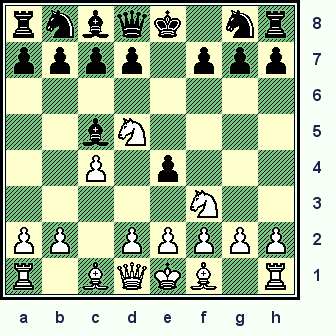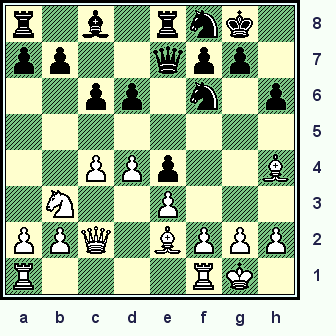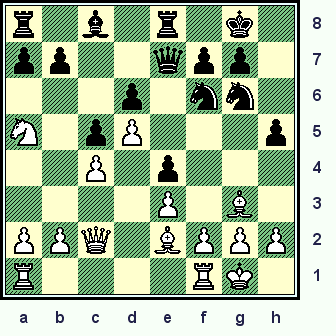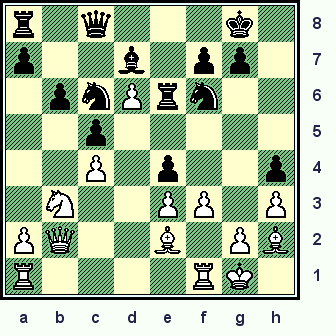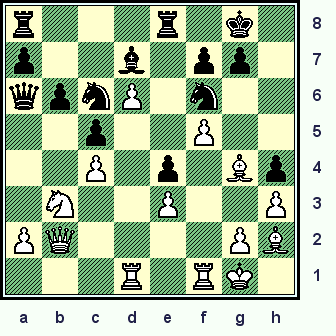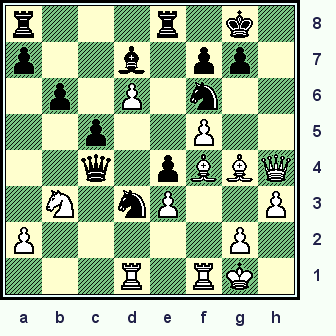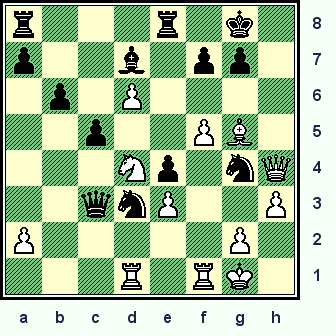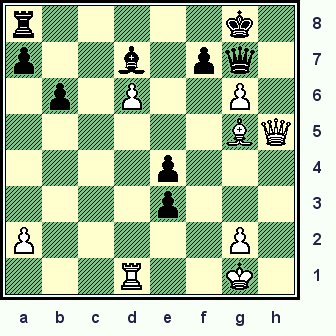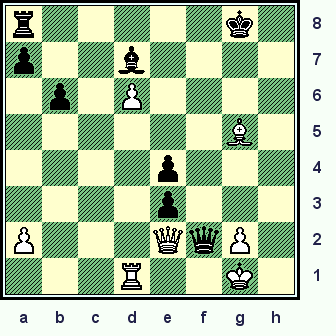All
the |
(Navigation bar
directly below.)
*******
© A.J. Goldsby,
2009.
(All rights reserved.)
****************
Click HERE
to see the page
for my downloads.
****************
Click HERE
to see any chess
items that I have
that are ...
FOR SALE!
****************
****************
Buy a book
from Amazon.com
(And help me out as well!)
Problem of The Week /
Supplementary game # 01
This was a game that I had gone over a few years ago, but I saw it again when I was studying with a local student.
I was very impressed with some of the tactics!!
Originally, I wanted to bash out just a quick analysis ... but it seems that I just cannot do this anymore. I decided that, "Anything worth doing, is worth doing right." Many of the questions about this combination had to be addressed. (I also received Fritz 9 while I was working on this game, I had ordered it about 2 weeks ago.) Also - I had not annotated that many English games, and I am quite certain that I had never covered this line in any detail. So I decided to go "whole hog," as we say down south.
(This was Puzzle Number # 33; for Monday / January 30th, 2006. Click here to see that page.)
This is primarily a text-based game ... to follow all of the analysis ... you will probably require a chess board.
Click HERE to see an explanation of the symbols that I use when annotating a chess game.
Click HERE to replay this game on a java-script replay board ... on a web page ... on another server.
FM A. Gunnarsson (2289) - GM I. Sokolov (2658)
|
|
|
rnbqk1nr/pppp1ppp/8/2bN4/2P1p3/5N2/PP1PPPPP/R1BQKB1R w
***********************************************************
I am not saying that this move is not less than best ... in fact, it probably is! But judging from the computer's evaluations, I cannot prove that this move is inferior ...not beyond all reasonable doubt.
[ Apparently, Black should instead play the continuation of:
>/= 4...c6; ('!')
5.Nc3 d6; 6.g3 Nf6;
7.d3 0-0; 8.Bg2 h6; 9.0-0 Be6;
10.b3 Bb6; 11.e3 Re8;
12.Ba3!? Bc7; 13.Qc2 Bf5; 14.h3 Nbd7;
15.Rad1 Rc8; 16.Nd2,
"~" (Maybe "=/+") {Diagram?}
Black equalized out of the opening, and then went on to win a long game.
GM Mikhail Gurevich
(2688) - GM Zoltan Gyimesi
(2571);
2nd EU-ch / Ohrid,
Macedonia; (R #5) /
05,06,2001.
(This game is annotated in the CB 2005 "MEGA" database,
if you happen to have it.)
]
5.d4!?, (center + tempo)
A good move, and one that is favored by masters, at least according to the statistics of the
(MEGA) database.
[ The try of: 5.Ng5!?, (Maybe - '!') "+/=" was worth serious investigation. ]
This position has only occurred about a dozen times, according to repeated searches of various {different} databases.
Normally, Black has played 5...Bf8; but this strikes me as retarding the second player's overall development. {Both players continue the opening phase by continuing to bring out
new pieces, and also both parties will have castled before move 15.}
5...Be7;
('!') 6.Nd2 c6;
7.Nxe7 Qxe7; 8.Qc2 Nf6;
9.Nb3 0-0;
This is OK, but maybe a bit too routine? (Maybe 9...h6!?)
[ (>/=) 9...d5!?; 10.Bg5 dxc4; "<=>" ]
10.Bg5 Re8; 11.e3 d6;
A cautious move, and this might be Black's best course of action.
(Since White has two Bishops, it is not in Black's best interests to open up the game.)
[ Also possible was:
11...d5!?; 12.a3 dxc4!?;
This looks interesting.
(Playing the Queen to d6, or even ...Nbd7; were worth a look as well.)
13.Bxc4 Nbd7; 14.Rc1,
"+/=" when White has a small edge, but
Black's position appears to be solid and playable. {There were no
matches in any database for this position.}
]
12.Be2 Nbd7;
13.0-0 h6; 14.Bh4, "+/=" 14...Nf8; (re-deployment)
White remains a bit better, he has the two Bishops and Black's position remains congested.
{See
the diagram - just below.}
***********************************************************
|
|
r1b1rnk1/pp2qpp1/2pp1n1p/8/2PPp2B/1N2P3/PPQ1BPPP/R4RK1 w
***********************************************************
I am not exactly sure where Black went wrong, (maybe move two?); but Black's game here - while reasonable - is not exactly what I would call ... "the ideal position."
[ Possible was:
14...b6!?;
{Diag?} as one student ...
at our local chess club ... suggested.
]
White to play, what's the best move that Gunnarsson has in this position?
15.d5!?, (Maybe - '!')
This fixes the Black Pawn on d6, making it a permanent target for attack.
Shredder 9.0 prefers >/= 15.Na5, "+/=" here for White. Another plan was 15.Nd2, followed by massing the Rooks in the center. When the time was right, White could then break with f2-f3.
[ Also interesting was: 15.c5 d5; 16.Na5, "+/=" with an edge for White. ]
15...c5!?;
"~" (key position)
{See the
diagram - just below.}
Trying to close lines.
***********************************************************
|
|
r1b1rnk1/pp2qpp1/3p1n1p/2pP4/2P1p2B/1N2P3/PPQ1BPPP/R4RK1 w
***********************************************************
An interesting situation has arisen, on the chess board and one that is rich in chances for both sides.
[ The authors of the English book recommend that Black play:
(>/=)
15...cxd5; 16.cxd5 Ng6;
17.Bxf6 Qxf6; 18.f4 exf3;
19.Rxf3,
"~" (Maybe "+/=")
{Diagram?}
with a slight pull. (White is supposed
to have a small advantage
here, but Black looks perfectly OK to me.)
*********************************************************************************
Maybe the best line was:
>/= 15...Ng6!;
16.Bg3 c5;
"~"
(Very close to equal.) ]
16.Na5 Ng6;
17.Bg3 h5; hmmm {See
the diagram - just below.}
Again - the authors of the English book brand this as dubious, ('?!'); and claim that 17...Bg4; was just a little better. And while they may be correct, the game might have wound up as a dull draw ... that no one would have remembered.
***********************************************************
|
|
r1b1r1k1/pp2qpp1/3p1nn1/N1pP3p/2P1p3/4P1B1/PPQ1BPPP/R4RK1 w
***********************************************************
For my part, (as a Master); I will note that the move looks playable, and that it is also the first (move) choice of a few fairly strong chess programs. It is also important to note that this move does NOT cause an appreciable shift in the computer's overall assessment of the position ... which is probably a good indicator that if Black went astray, it was not on this turn.
The other side of the coin is that this move DOES represent a permanent weakening of Black's King-side, and therefore might deserve some of the criticism that this particular play has received.
[ Another thought was: >/= 17...Ne5; with a playable position for Black. ]
18.h3 h4;
19.Bh2 Qc7; 20.b4!, (pawn-lever)
Trying to break into Black's Queen-side here.
[ Or 20.Qc3, "~" (about equal). ]
20...Bd7;
('!?')
(developing)
Maybe the most prudent course for Black here. (Although both 20...b6 and 20...Bf5 might have been slightly better than the course of the actual game, although this point
goes unnoticed by our two authors.)
[ Or if Black should play: 20...cxb4!?; then White plays: 21.Qa4, "~" ("/\"). ]
The series of the next few moves should be relatively easy for most players to understand.
21.Qd2 Ne5; 22.bxc5 dxc5; 23.d6 Qc8;
24.Qb2 Nc6;
25.Nb3 b6; 26.f3!? Re6!?; {See
the diagram - just below.}
Is Black going for the full point? (Probably.)
Is this the wisest course that he can take? (Maybe not.) {Probably - '?!'}
***********************************************************
|
|
r1q3k1/p2b1pp1/1pnPrn2/2p5/2P1p2p/1N2PP1P/PQ2B1PB/R4RK1 w
***********************************************************
But it makes for interesting chess ...
[ (>/=) 26...exf3; 27.Bxf3 Qa6; "~" ]
27.Rad1 Qe8;
Black piles up on the e-file ... (Playing 27...Rb8; was also a thought here.)
[ I must also note that Black could play
27...Qa6;
"~" here - and saved
several tempo over the game. ]
Now White ensures that the e-file will remain closed, thus ensuring that the Rook on e6 has some difficulty finding active play.
28.f4! Qc8;
Perhaps giving notice that Black thinks his Rook on e6 needs a (better) square, and maybe also an admission that his earlier plan (...Re6; and then ...Qe8); wasn't really all that great.
[ 28...Nh7!?; "=" - Fritz 8.0 ]
29.f5 Re8; 30.Bg4!?
Qa6!?; {See
the diagram - just below.}
This might be OK, perhaps the strategy of playing defence (with 30...Rd8) did not appeal to the big-time GM here. (Maybe - '?!')
***********************************************************
|
|
r3r1k1/p2b1pp1/qpnP1n2/2p2P2/2P1p1Bp/1N2P2P/PQ4PB/3R1RK1 w
***********************************************************
Maybe ... just maybe ... this was the last concrete opportunity for Black to improve his play.
[ Possibly this was Black's last (real) chance to play the following
continuation of:
(>/=)
30...Nxg4; ('!') 31.hxg4
Qa6; "~" {D?}
and try to defend his position.
(31...Nb4!?; was also worth a look for Black in this position.) ]
Now White "goes for broke" with an all-out K-side attack.
31.Qf2!,
(Maybe - '!!')
A token of things to come, White disdains the idea of 31.Be2, with simple equality.
[ >/= 31.Be2, "=" according to Fritz 8.0. ]
31...Qxc4;
"~" ("=/+") (Maybe - '!')
Now Fritz awards a solid plus to Black, but we all know that the bloody box is too materialistic. (31...Nb4 was also worth serious consideration by Black.)
32.Qxh4 Ne5; ["D" ... or "O?"]
Heading for the d3-square.
(>/= 35...Nb4; might have been more accurate, and would not have given White the
opportunity to capture the Knight on e5.)
Now White (re) activates his dark-squared Bishop.
33.Bf4! Nd3; hmmm
{See the
diagram - just below.}
Sokolov goes ahead and sinks the Knight into the d3-square.
[Now this could be dubious here for Black, Fritz prefers 33...Rac8. (Which makes sense, one of the reasons that Black almost loses this game ... near the very end, a hanging QR on a8 could have led to his downfall.)]
***********************************************************
|
|
r3r1k1/p2b1pp1/1p1P1n2/2p2P2/2q1pBBQ/1N1nP2P/P5P1/3R1RK1 w
***********************************************************
Now the position has become utterly scrambled ... its hard to tell who is better here.
[ The sensible try of: (>/=) 33...Bb5!?; was (also) worth a look here for Black. ]
White to move in this position.
34.Bg5!?, (Maybe - '!')
Perfectly logical ... it looks very good indeed.
(But Raetsky and Chetverik award the '?!' sign.)
[ Only later did GM Helgi Olafsson point out the following win, which
is very beautiful ... and might be nearly impossible to try and find
over the board:
>/= 34.Bh6!! Qc3!; 35.Nd4!! gxh6!?; {This could be best for Black.}
(But not: <35...cxd4??; 36.Qg5, "+/-")
36.Qxf6! cxd4!?; 37.Qxh6!,
'±' {Diagram?}
when the Black King will probably fall victim to an onslaught from the
remainder of White's pieces.
( One sample variation is:
37.Qxh6! Ne5[];
38.Rxd4 f6;
If the Black Knight goes to c4, White simply captures it,
to be followed by f6, with a mating web around the Black King.
39.Bd1!! Rac8!?;
40.Bb3+ Nc4;
41.Qg6+! Kh8; 42.Qxf6+,
42...Kg8; 43.Qg6+ Kf8;
44.f6!! Qxe3+;
45.Kh2!, "+/-" {D?}
and Black must start playing "give-away" to prevent mate. )
]
Now Black uses his Queen to defend f6 from afar ...
(34...Nxg4; 35.f6!! is similar to the game, and would just transpose after 35...Qc3; 36.Nd4!)
34...Qc3;
('[]' ?) 35.Nd4!, ('!!')
A problem-like interference.
(The authors A. Raetsky and M. Chetverik only award this move one exclam, and I follow
suit. However, if I were annotating this game for the first time, I would be inclined to give it two, as not even Fritz 9 finds this shot.)
[ Or 35.Nd2 Rad8; 36.Be2, "~" ]
35...Nxg4;
(forced?) {simplification}
{See the
diagram - just below.}
Now this looks to be Black's best play ... and Fritz agrees with this assessment of this move.
***********************************************************
|
|
r3r1k1/p2b1pp1/1p1P4/2p2PB1/3Np1nQ/2qnP2P/P5P1/3R1RK1 w
***********************************************************
The position has become more and more complex, even the boxes start to lose their way here.
[ The move of: 35...Nh7!?; was another idea for Black.
But now (the continuation of):
36.Bh5! Ne5;
37.Ne2 Qa3!?;
38.f6,
'±' (With an attack.)
yields White a ton of pressure.
]
It is White to play here.
36.f6!!, (Maybe - '!!!')
An extremely brilliant shot.
(Not even all the programs discover this one, even after 5-10 minutes of machine time.)
To add to the headache, (for White AND Black!); this is the part of the contest when one {or both} side(s) are generally in time trouble.
"Black most likely missed this. Now his King is in great trouble."
- A. Raetsky and M. Chetverik
[ I feel sure that GM I. Sokolov probably expected his opponent
to play:
36.Qxg4,
"~" when Black has no real problems. ]
36...Nde5!;
(good defense)
Black forgets about material, and tries to maintain a watch over the crucial f6 and h6 squares.
[ Var. # 36B01)
Black should not play:
</= 36...cxd4?!; 37.fxg7 f5;
Probably no choice here.
( </= 37...Kxg7?; 38.Bf6+ Nxf6[];
39.Qxf6+ Kh7; 40.Qxf7+ Kh8;
41.Qh5+ Kg8; 42.Rf7, ("+/-") and mates. )
38.hxg4 dxe3; 39.Qh8+ Kf7;
40.g8Q+ Rxg8; 41.Qxc3, "+/-"
and White is winning here.
****************************************************************************
Var. # 36B02)
Worse {than the above} would be the continuation:
</= 36...Nge5?; 37.fxg7 Ng6;
38.Qh6 f5[]; This is forced.
( If </= 38...cxd4?;
then 39.Bf6!, "+/-" {Diagram?}
with an unstoppable mate coming up on the h8-square. (R & C) )
39.Qxg6 cxd4; 40.Qh6 dxe3!?;
Several different programs seem to indicate that this is forced for Black.
( Even worse would be:
</= 40...Re5?; 41.Rxd3! exd3;
42.Qh8+ Kf7; 43.g8Q+ Rxg8;
44.Qf6+, ("+/-") and mate in 3. )
41.Qh8+ Kf7; 42.g8Q+ Rxg8;
43.Qxc3, ("+/-")
{Diagram?}
and Black could call it quits here.
****************************************************************************
Var. # 36B03)
Simply a nightmare for Black is:
</= 36...gxf6?; ('??')
37.Bxf6 Nxf6;
38.Qg5+ Kf8; 39.Qxf6 Kg8;
40.Qxf7+ Kh8; 41.Rf6,
"+/-" Black will be unable to avoid mate.
- A. Raetsky and M. Chetverik. (They end their line with Qg5+.)
****************************************************************************
Var. # 36B02)
Possibly worth investigation was the continuation of:
36...Nxf6!?; 37.Bxf6 gxf6;
38.Rxf6 Ne5; 39.Qg5+ Ng6;
when White could claim a draw with the simple
RxN/g6+,
or play for a win with >/=
40.Rdf1! ]
37.fxg7!, (en gracio)
White does not take his eyes off the prize, and continues the attack.
[ Possible was: 37.hxg4!? ]
37...Ng6; ('!')
38.Qh5 cxd4[];
This is best or virtually forced, although 38...Re5; was worth some serious investigation.
[ But Black certainly cannot allow:
</= 38...N4e5?; 39.Bf6!,
"+/-"
with an unstoppable mate.
(On the h8-square.) ]
39.hxg4 Re5!; (nice)
{See the diagram
- just below.}
Black must stop the Bf6 idea (again) by White, as this leads to a mating net.
(See the note after Black's 38th move, just above.)
***********************************************************
|
|
r5k1/p2b1pP1/1p1P2n1/4r1BQ/3pp1P1/2q1P3/P5P1/3R1RK1 w
***********************************************************
Black seems to be holding the {overall} balance ...
Now White drops another stunner onto the playing field.
40.Rf5!! Rxf5; ('!?'/'?!')
This should lose ... but so does everything else.
[
Var. # 40B01)
Or
40...Kxg7!?; 41.Bf6+ Kg8;
42.Rxe5 Qxe3+; 43.Kh1 Qf4; 44.g5,
"+/-"
and White should win. (An 'eval' of + 2.75 by Fritz 8.);
********************************************************************************************
Var. # 40B02)
Also of no help was: (</=) 40...Qc2!?;
41.Bf6!! Qxd1+; 42.Kh2, "+/-"
and once more ... White has the unstoppable mate on h8. ]
The next few blows look to be best ... and nearly forced for both players here.
41.gxf5 dxe3; 42.fxg6 Qxg7[]; {See
the diagram - just below.}
This move was probably forced for Black, (just about any other move loses on the spot).
***********************************************************
|
|
r5k1/p2b1pq1/1p1P2P1/6BQ/4p3/4p3/P5P1/3R2K1 w
***********************************************************
Despite all the complications, the GM appears to be 'holding the fort,' as we say down south.
[ </= 42...fxg6??; 43.Qh8+ Kf7; 44.g8Q+ Rxg8; 45.Qxc3, "+/-"
****************************************************************************
</= 42...Kxg7??; 43.Qh7+ Kf8; 44.Qxf7#. ]
Now please study the position very carefully. White to move - what play would you make here?
43.gxf7+?!,
(Really - '?')
Amazingly enough, White missed a win in this position.
[The authors of a book on the English give this two question marks, ('??') but I reserve that appellation for a terrible mistake or even a gross blunder.]
It IS a shame that White missed all of this, as this would have made this a chess game for all the ages. (Was Gunnarsson short of time?)
[ White should have played:
>/= 43.Bf6! fxg6;
{Box?}
Practically Black's only move.
***** ***** ***** ***** ***** ***** ***** ***** ***** ***** ***** *****
( Not </= 43...Qxg6?; 44.Qh8#.
** ** ** ** ** ** ** ** ** ** ** ** ** ** ** ** ** ** ** **
Or 43...Qxf6!?; ('?!') 44.Qh7+ Kf8;
45.Rf1 Qxf1+;
46.Kxf1 Bb5+;
47.Ke1 fxg6[]; Otherwise Black gets mated.
48.Qh8+ Kf7; 49.Qxa8, "+/-" with a very easy win. )
***** ***** ***** ***** ***** ***** ***** ***** ***** ***** ***** *****
44.Qd5+ Qf7[]; (Otherwise, Black loses the Queen.)
45.Qxa8+ Qf8[];
---> This is (probably) forced.
(And not 45...Kh7??; because White replies with 46.Qh8#.)
46.Qd5+ Qf7; 47.Qg5,
"+/-" {Diagram?}
and White is a Rook ahead. (A fairly straight-forward win,
although White must exercise some caution with Black's two
e-pawns still on the board.) ]
43...Qxf7; 44.Qe2 Qf2+!?; {See
the diagram - just below.}
... and the players agreed to a draw in this position. ("=" maybe "+/=")
***********************************************************
|
|
(The final position.)
***********************************************************
A game full of interesting tactics, unusual positions, and extremely dense variation trees.
*************************************************************************************
BIBLIOGRAPHY:
<< "The English with 1...e5." (Reversed Sicilian Lines.) >>
By Alex Raetsky and Maxim Chetverik. (Game # 71, page # 181.)
Copyright by the authors (and also the translator), (©) 2003.
Published by Everyman Chess. ISBN: # 01-85744-339-X (flex)
[This book on Amazon.com] [This book on Chess Cafe / USCF booksellers.]
*************************************************************************************
Copyright (c) A.J. Goldsby, 2006. All rights reserved.
½ - ½
The analysis for this page was prepared with the excellent program, ChessBase 9.0. The HTML was polished with several different tools and programs, (mostly FP) ... the text was checked for spelling with MS Word. The diagrams were created with the program, Chess Captor 2.25.
|
